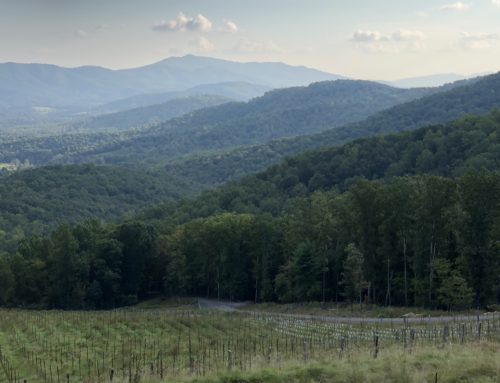The dream of a world class Virginia wine began with Thomas Jefferson. Although Jefferson knew that Virginia had the weather and terroir for grape growing and winemaking, he never saw his dream come to fruition. This is, in part, due to Phylloxera—an aphid-like insect that feeds on the roots and leaves of grapevines. However, Virginia grape growers now understand that to successfully grow European grapes, they must first graft the vine onto phylloxera resistant American rootstock. This was the first major hurdle to realizing the dream of a Virginia wine, the next, proving the viability of grape growing as an agricultural endeavor.
Officially, the wine industry in Virginia began in 1976 with the Zonin family, one of Italy’s largest wine producers. They bought Barboursville in Orange, an area near Charlottesville, with the hopes of starting a vineyard. Underlying this decision was the belief that European grapes could thrive in the Commonwealth of Virginia. After the purchase of Barboursville, the Zonin family invited Gabriele Rausse, an Italian winemaker, who is currently the Director of Gardens and Grounds at Monticello, to assist in making the dream of a Virginia wine a reality. Today, the Commonwealth boasts hundreds of successful wineries and vineyards, many producing award winning wines–including Barboursville Vineyards, Virginia’s first commercial winery. And, Gabriele Rausse is partially responsible, having consulted on 40 vineyards and 10 wineries in the Commonwealth, including his own. He is considered the father of modern Virginia wine.
Grape growing and winemaking in Virginia have been firmly established for almost 30 years, and many have lead the way in this fast growing agricultural industry. Rutger De Vink, a Dutch-born, retired Marine officer with an MBA from Northwestern University and a background in the telecom business, is both idealistic and passionate about his vision of making a Virginia wine that ranks among the world’s best. Initially a novice, de Vink has no formal education in viticulture or winemaking; however, he participated in an apprenticeship with Jim Law of Linden Vineyards in Virginia in 2001. He then proceeded to work on vintages in Sonoma, Saint-Émilion, and Saint-Julien. After gaining experience, it was time to look for a vineyard. He settled on a 100-acre farm and planted grapevines on 16-acres of rocky topsoil on a hillside of granite in Delaplane, Virginia. RdV Vineyard, named for Rutger de Vink, is a small, boutique winery located about 50 miles west of Washington, D.C.
According to the guide at RdV, de Vink chose this unusual spot for his vineyard after researching soils that grow the best grapevines. What he discovered was soil with good drainage appeared to be the key to great terroir. He understood that grapevines need to struggle a bit. If they’re grown on a flat, fertile ground, then all the energy goes into the plant, leaves, and trunk. However, growing vines on a rocky hillside where they’re stressed for moisture and nutrients encourages the plant to go into survival mode by focusing its energy into the fruit. The plant makes really ripe fruit that may be eaten by a bird that drops its seed on more fertile ground. It’s Mother Nature at work. That aside, these really ripe grapes also make better wine. De Vink is meticulous and steadfast in his quest for excellence. The vineyard is separated into sections or blocks with each block analyzed for its soil nutrients, drainage, and sun exposure. These blocks are planted with a specific grape that thrives under those particular conditions; they are then hand-harvested and sorted.
De Vink made his first wine in 2008 and shared it with a friend in Bordeaux, who then sent a sample of his Cabernet Sauvignon to Eric Boissenot. Boissenot is one of the most important consultant-enologists in the world. Based in the Médoc, he currently consults and blends for all five First-Growths of Bordeaux (Château LaFite Rothschild, Château Latour, Château Margaux, Château Haut-Brion, and Château Mouton Rothschild) as well as other Bordeaux estates. First Growth is a term referring to a classification of wines, generally from the Bordeaux region of France. Also known as Premier Cru, First Growth wines are the top wines in the Bordeaux Wine Official Classification of 1855.
Boissenot’s particular interest is in the influence of soil on wine quality, and because he thought the terroir of these Virginia wines was so stunning, he volunteered to consult with Rutger de Vink and RdV Vineyard. RdV is the only vineyard in the United States that receives input from Eric Boissenot. The vineyard produces two wines, Rendezvous and Lost Mountain, using Cabernet Sauvignon, Merlot, Petit Verdot and Cabernet Franc. Rendezvous is more Merlot-based (right bank Bordeaux style); whereas, Lost Mountain has at least 70% Cabernet Sauvignon (left bank Bordeaux style); these wines are barrel aged for 18-20 months in French oak. While Rendezvous and Lost Mountain are on the expensive end of the price spectrum, de Vink’s wines are worth it.
Here’s the thing: Rutger de Vink and RdV Vineyard are quickly gaining notice and for good reason: Beautiful wines that are a cross between Napa and Bordeaux, characterized by the perfect balance of fruit and minerality. Characteristics that combine to produce a stunning, velvety wine that is truly sensational—a Bordeaux-style wine with a Virginia terroir. These boutique-style wines are becoming highly sought-after and collectible. On one of our recent visits, we learned that the 2013 vintage of Lost Mountain won in blind tastings against two of France’s First Growths: Château Latour and Château Margaux as well as besting California’s Opus One. I think Thomas Jefferson would have been proud!
**If you’re interested in visiting RdV Vineyard, call ahead; wine tastings are by appointment only. The tour and tasting are extensive and well worth the price. On approaching the winery, you may think that you’re driving toward another lovely farm in Delaplane, complete with barn and silo; however, upon entering the building you are transported into a completely modern, industrial space with lots of natural light. It’s definitely an experience you won’t forget.


